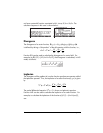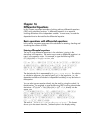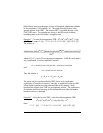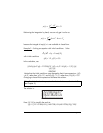
Page 16-4
These functions are briefly described next. They will be described in more detail
in later parts of this Chapter.
DESOLVE: Differential Equation SOLVEr, provides a solution if possible
ILAP: Inverse LAPlace transform, L
-1
[F(s)] = f(t)
LAP: LAPlace transform, L[f(t)]=F(s)
LDEC: solves Linear Differential Equations with Constant coefficients, including
systems of differential equations with constant coefficients
Solution to linear and non-linear equations
An equation in which the dependent variable and all its pertinent derivatives
are of the first degree is referred to as a linear differential equation
. Otherwise,
the equation is said to be non-linear
. Examples of linear differential equations
are: d
2
x/dt
2
+ β⋅(dx/dt) + ω
o
⋅x = A sin ω
f
t, and ∂C/∂t + u⋅(∂C/∂x) = D⋅(∂
2
C/
∂x
2
).
An equation whose right-hand side (not involving the function or its derivatives)
is equal to zero is called a homogeneous equation. Otherwise, it is called non-
homogeneous. The solution to the homogeneous equation is known as a
general solution. A particular solution is one that satisfies the non-
homogeneous equation.
Function LDEC
The calculator provides function LDEC (Linear Differential Equation Command)
to find the general solution to a linear ODE of any order with constant
coefficients, whether it is homogeneous or not. This function requires you to
provide two pieces of input:
• the right-hand side of the ODE
• the characteristic equation of the ODE


















